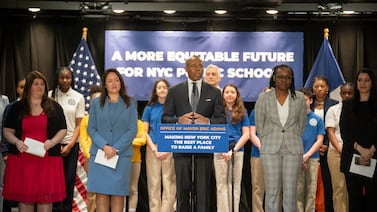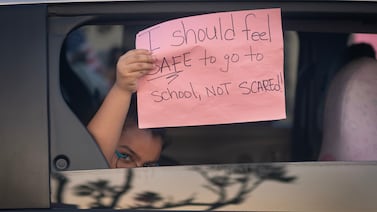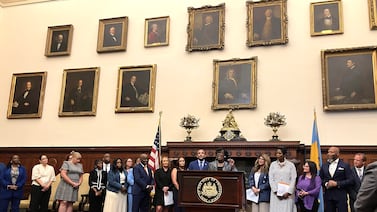Sign up for Chalkbeat New York’s free daily newsletter to get essential news about NYC’s public schools delivered to your inbox.
Thousands of low-income New York City families could see their child care vouchers abruptly yanked away if the state doesn’t add nearly a billion dollars to the program in the coming budget, advocates and city officials have warned in recent weeks.
The Child Care Assistance Program, which provides vouchers averaging $300 a week to nearly 80,000 families, saw a boom in enrollment across the five boroughs over the past several years thanks to pandemic eligibility changes and an infusion of one-time federal funding.
But the program is now facing a perfect storm of budgetary threats as federal aid dries up, child care costs continue to rise, and COVID-era waivers that likely kept many families home with their kids expire, leaving a massive funding shortfall.
As a result, if state funding for the program doesn’t increase next year, the city may have to begin removing vouchers from between 4,000 and 7,000 low-income families each month, according to an analysis from the Center for NYC Affairs at the New School.
That would be a major hardship for Mansie Meikle, a Queens mother of three who uses the vouchers to subsidize the cost of after-school care. She said she was unable to work before getting the vouchers because she couldn’t afford child care. Now, she worries she could end up “right back at square one.”
“I fought three years to get out of that cycle of not having child care and to just think of being back in that place, it’s really, really not a good feeling at all,” she said.
Overall, the city would need between $823 and $907 million in additional state funding over the next year and a half in order to avoid kicking families out of the voucher program, the New School analysis estimates.
Gov. Kathy Hochul’s executive budget proposal includes no increase in funding for the vouchers, while the senate’s plan adds $50 million, and the assembly adds $213 million, according to New York Focus, which first reported the funding shortfall.
The state’s budget is supposed to be finalized by April 1.
Avery Cohen, a Hochul spokesperson, said the governor has “increased funding for childcare subsidies in New York City by 124% while City spending has remained relatively flat.”
“We will continue to support these vital programs and ensure as many families remain enrolled as possible,” Cohen added.
Some city and state lawmakers have criticized Mayor Eric Adams for not being proactive enough about the looming shortfall and failing to make it a priority in budget negotiations with the state.
Allison Maser, an Adams spokesperson, said the “vouchers have been integral to our efforts in reducing the cost of child care.” City officials said they have held nearly 200 meetings with state lawmakers about the voucher program in the last month.
A victim of its own success
The voucher program’s current precarious financial position is, in some ways, a result of its resounding success in recent years, advocates said.
Prior to the pandemic, most vouchers went to families receiving cash assistance, a state welfare program for families out of work or whose jobs don’t pay enough. Typically under that program, parents are required to work, and the state is obligated to provide them child care vouchers.
During the pandemic, the state lifted work requirements for parents receiving cash assistance, which advocates said likely led to more families staying home, leaving them with less need for child care. The number of vouchers for families receiving cash assistance dropped from more than 51,000 in 2017 to a low of just over 19,000 in 2022, according to the New School analysis.
That huge drop, combined with extra federal relief funds, allowed the state and city to open the program to a wider swath of low-income families who do not receive cash assistance. The state raised the eligibility threshold to 85% of the state median income, or about $108,000 for a family of four.
In a city where child care remains unaffordable for all but the wealthiest families, newly-eligible families leapt at the offer. Child care vouchers for families not receiving cash assistance increased from 18,000 in 2021 to 56,000 last year.
“Families have flocked to the program because it’s a really good program,” said Dede Hill, director of policy at Schuyler Center for Analysis and Advocacy.
At the same time, state officials nearly doubled the average value of the vouchers, from $154 in 2019 to $301 last year, to meet the rising cost of child care — a change applauded by families and providers.
But the program now faces a funding cliff.
Federal funds that helped subsidize the program’s growth during the pandemic have dried up. And most importantly, the pandemic waiver allowing families to qualify for cash assistance without work requirements is set to expire.
Analysts and city officials predict the end of the waiver will lead to a surge in employment among families receiving cash assistance. And since the state is required to provide child care vouchers for those families, officials expect a concurrent surge in vouchers for families getting cash assistance — from roughly 23,000 currently to as many as 66,000 by March of 2026, according to the New School analysis.
To create room in the budget to fund all the new vouchers for families getting cash assistance — whose child care the state is legally required to subsidize — the city will have to take them away from families not receiving cash assistance. City officials have estimated that could affect between 4,000 and 7,000 families a month.
Advocates, providers warn of ‘ripple effects’
Beyond the devastating impact for individual families, a mass removal of vouchers could destabilize the child care sector, advocates and providers warned.
“This will have a ripple effect,” said Tiffany Diaz, owner and operator of several Bronx home-based day care programs. “In my sites…85% of our income comes from vouchers. Can you imagine 85% of your wages being pulled from under you? I’m not sure how we would be able to survive.”
And if families are unable to afford child care, “they will not be able to then go out to the workforce and contribute to society and contribute to this, this economy,” Diaz added.
Some families might be able to fill one of the more than 11,000 vacant extended school day and year seats in the city’s publicly funded preschool programs for kids up to four years old, the New School analysis pointed out. But funding for some of those programs also remains in question.
Other families, unable to work without access to affordable child care, may end up relying on additional public assistance — underscoring why advocates say the eye-popping number needed to stabilize the voucher program is a worthwhile long-term investment.
“Research shows that investing in child care has massive returns for society,” said Jason Cone, chief public policy officer at Robin Hood. “We have greater workforce participation, predominantly amongst women, who are able to enter the workforce, generate higher incomes and eventually pay more taxes. And it’s a good thing for children as well.”
Michael Elsen-Rooney is a reporter for Chalkbeat New York, covering NYC public schools. Contact Michael at melsen-rooney@chalkbeat.org






